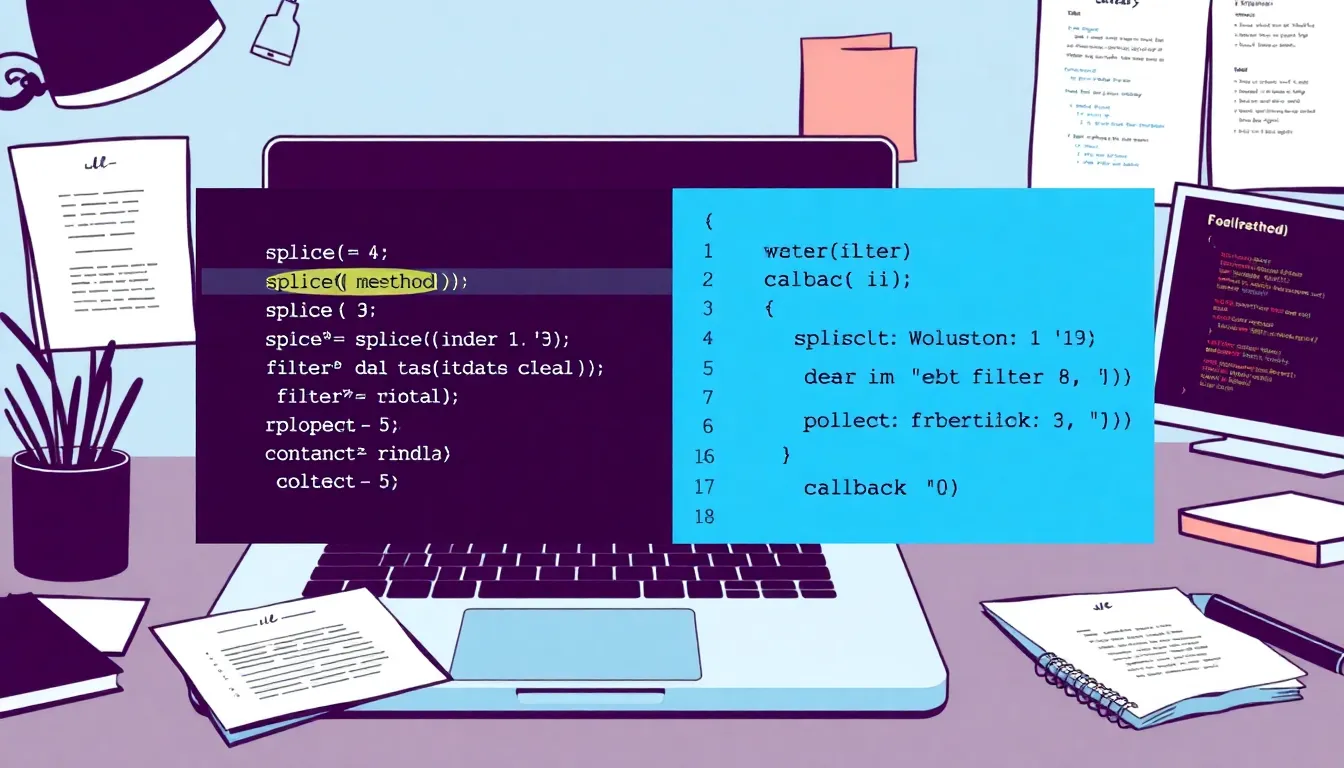In the world of JavaScript, arrays are like a buffet—full of delicious data, but sometimes you just don’t want that mystery meat on your plate. Whether it’s a pesky item that’s overstayed its welcome or a data point that simply doesn’t belong, knowing how to remove an element from an array is a skill every developer should master.
Table of Contents
ToggleUnderstanding Arrays in JavaScript
Arrays in JavaScript serve as vital data structures, capable of storing multiple values in a single variable. Elements within these arrays can be of various data types, including numbers, strings, and even other arrays. Developers often utilize arrays to manage lists of data, making operations like adding, removing, or modifying elements essential.
Accessing an array element occurs through its index. The first element is found at index zero, while subsequent elements follow in ascending order. This indexing system allows quick, direct access to any given value within an array.
Manipulating arrays involves several built-in methods. The push method adds elements to the end, while pop removes the last element. These actions provide a dynamic way to manage array content. Conversely, the shift method removes the first element, and unshift adds a new element to the start.
Understanding how to identify and remove specific elements enhances a developer’s ability to maintain clean, efficient datasets. For instance, the splice method facilitates removal by specifying the index and the number of elements to delete.
Utilizing iterations, like forEach or map, allows developers to traverse arrays and perform actions on each element. This technique efficiently handles operations across large datasets.
Overall, mastering array manipulation fosters better data organization and enhances application performance. Commencing with an understanding of arrays leads to more complex operations like element removal, providing developers with essential skills for efficient coding.
Common Methods to Remove Elements

Several methods simplify the removal of elements from arrays in JavaScript. Developers frequently use splice() and filter() for this purpose.
Using splice()
The splice() method removes elements based on their index. This method changes the original array, making it effective for in-place modifications. To utilize splice(), developers specify the index to start removing from and the number of elements to delete. For example, array.splice(2, 1) removes one element starting from index two. This approach supports removing specific elements, providing control over the array contents directly.
Using filter()
The filter() method creates a new array by retaining elements that meet defined criteria. Unlike splice(), filter() does not modify the original array, making it a non-destructive option. Developers use a callback function to determine which elements to keep. For instance, array.filter(element => element !== value) generates a new array without the specified value. This method ensures flexibility while removing elements based on specific conditions.
Removing Elements by Value
Removing elements by value in JavaScript requires effective strategies. Developers often look for the best approaches to achieve this goal efficiently.
Finding the Index First
Finding the index of the element is a crucial first step. The indexOf() method is often used to determine the index based on the value. If the element exists, this method returns its index; otherwise, it returns -1. Checking whether an index is valid before removal helps avoid errors. Using this approach streamlines the removal process, ensuring that only elements present in the array are targeted.
Using indexOf() and splice()
Developers frequently use the combination of indexOf() and splice() for removing elements. After finding the index with indexOf(), they utilize splice() to remove the element from the array. This method modifies the original array, deleting the specified element at the determined index. It’s important to note that splice() can also handle multiple deletions by specifying a count. Utilizing both methods together provides a clear and effective way to remove elements by their value.
Removing Elements by Condition
Removing elements from an array based on specific conditions allows developers to create cleaner datasets. This process efficiently manages data by excluding unwanted elements without modifying the original array structure.
Leveraging filter() for Conditions
Using the filter() method enables developers to create a new array with only elements that meet their criteria. This method executes a callback function on each element, retaining those that return true. For example, to remove all negative numbers from an array, a developer might write:
const numbers = [1, -2, 3, -4, 5];
const positiveNumbers = numbers.filter(num => num >= 0);
In this case, positiveNumbers contains [1, 3, 5]. Developers appreciate filter() for its non-destructive nature, allowing for safer manipulations. This approach keeps the original array intact while providing a refined set of values based on defined conditions, enhancing data usability.
Tips and Best Practices
Use appropriate methods for removing elements from arrays in JavaScript. Opt for the splice() method to modify arrays in place, ensuring efficient element removal by index. The filter() method aids in maintaining data integrity by creating a new array only with desired elements. Retaining original data is crucial for many applications.
Identify elements effectively by using indexOf(). This method locates the index based on value, simplifying the removal process. For instance, combining indexOf() with splice() allows for straightforward removal of elements from an array. Avoiding invalid indices makes this combination particularly effective.
Consider performance when dealing with large arrays. Utilizing efficient iteration methods like forEach() can significantly speed up element removal tasks. Recognizing the performance implications helps maintain optimal application functionality.
Aim for readable and maintainable code. Clearly document the intent behind array manipulations, especially when conditions lead to element removals. Enhanced clarity supports future modifications and helps team members understand the code.
Test array removal strategies thoroughly. Check corner cases, such as attempting to remove non-existent elements, to ensure robust performance. Validating that implementations function as intended confirms reliability in real-world scenarios.
Review JavaScript updates regularly. Continuous improvements in the language can introduce new features or methods beneficial for array manipulations. Staying informed promotes adopting best practices in code development.
Mastering the techniques for removing elements from arrays in JavaScript is vital for developers. By utilizing methods like splice() and filter(), they can manage data efficiently while maintaining code clarity. Understanding when to apply destructive versus non-destructive methods enhances data integrity and usability.
Developers should also prioritize performance and readability in their code. As JavaScript continues to evolve, staying informed about new features and best practices will ensure effective array manipulation. With these skills, developers can create cleaner datasets and improve overall application performance, leading to more robust and maintainable code.




